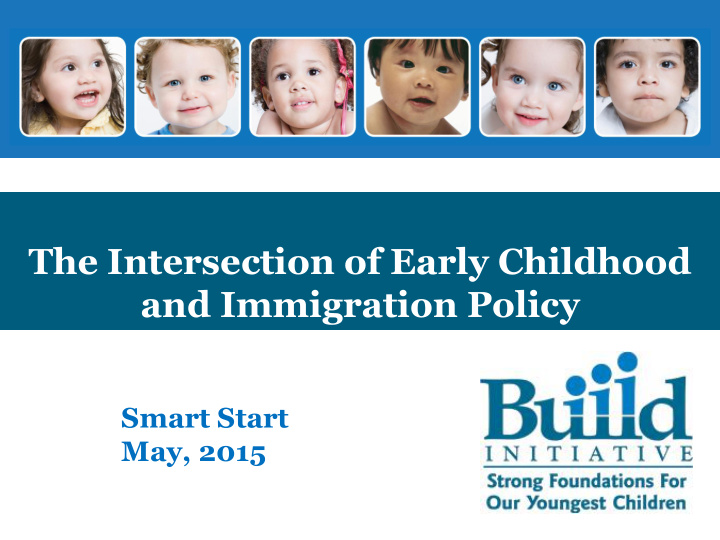



The Intersection of Early Childhood and Immigration Policy Smart Start May, 2015
Session Objectives • Reflect on immigration policies’ impact on young children in immigrant families • Discuss new executive actions that provide relief from deportations • Commit to on-going learning and action on behalf of immigrant families
1 in 4 Children in the U.S. Live in an Immigrant Family Table 1. Growth in the Share of Young Children (Ages 0 to 8) of Foreign-Born Parents in the United States, 1980-2012 10,000,000 25.0% 24.6% 9,000,000 8,000,000 20.3% 7,000,000 6,000,000 5,000,000 13.5% 4,000,000 10.5% 3,000,000 2,000,000 1,000,000 0 1980 1990 2000 2010 2012 Source: Park, Maki and Margie McHugh. 2014. Immigrant Parents and Early Childhood Programs: Addressing Barriers of Literacy, Culture, and Systems Knowledge. Washington, DC: Migration Policy Institute .
Nearly 9 out of 10 Children of Immigrants are U.S. Citizens Children (0-17) in Immigrant Families who are U.S.-Born Foreign Born 12% U.S. Born 88% Source: Migration Policy Institute tabulation of data from the U.S. Census Bureau’s 2012 American Community Survey and 1990 C ensus decennial data.
Immigration Policy & Children
Immigration & Child Development • As early as ages 2 and 3, a proxy for parental unauthorized status was associated with lower levels of standardized cognitive skills • Parental detention or removal is associated with increased economic hardship and negative psychological well- being of the child, disruptions in attachment and interruptions in schooling
Enrollment of Children of Immigrants in Pre-k Source: Diverse Children: Race, Ethnicity, Immigration in America’s New Non Majority Generation, Foundation for Child Development, July 2013
Elisabeth Montes One Family’s Story • Purpose • Instructions • The Challenge • Guiding Questions
Obama Administration Executive Actions • Announced in November 2014, deferred action for: – Parents of US citizen children or lawful permanent residents – Certain immigrants who have grown up in the United States • Opportunity to help 4.4 million people get relief from deportation!
What is deferred action? • Temporary status • Immigrant is considered to be lawfully present in the U.S. • Immigrant may apply for employment authorization document • Eligible to get a driver’s license, bank accounts • Does not qualify the immigrant for public benefits
Who qualifies for DAPA? • Parent of a U.S. citizen or legal permanent resident child • Continuous residence in the U.S. since January 1, 2010 • No criminal convictions • Granted on a case by case basis
Who qualifies for expanded DACA? • Come to the U.S. before your 16 birthday • Continuous residence in the U.S. since January 1 st , 2010 • Present in the U.S. on June 15, 2012 • Graduated or obtained a certificate of completion from high school, GED, or “in school” • No criminal convictions • Granted on a case by case basis
What’s happening now with administrative relief? • Immigrants that are eligible for the DACA program announced June 15, 2012 can apply – Continuous residence since June 15, 2007 – Born on or after June 16, 1981 • A federal District court has issued an order that temporarily blocks DAPA and expanded DACA programs from being implemented.
What is the role for early childhood programs? • Raise awareness in your program & community • Train staff to have informed conversations with families • Develop partnerships with trusted organizations • Connect families with trusted legal resources • Help families begin saving for the fees • Help families request background checks • Gather evidence and documentation of continuous residence in the U.S.
Resources • Mobile app is a step by step aid for DACA applications: citizenshipworks.org/mobile • www.adminrelief.org • www.nilc.org/relief.html • www.iAmerica.org • www.unitedwedream.org
Questions, Reflections, Comments
Thank You Contacts: Miriam Calderon, miriamelena8@gmail.com Consultant, Build Initiative
Recommend
More recommend